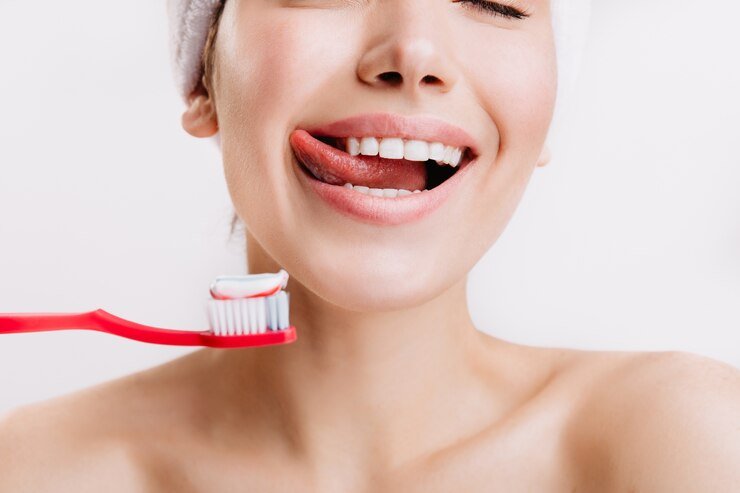Teeth whitening strips are thin, flexible plastic strips coated with a gel containing peroxide, the active ingredient responsible for whitening teeth. These strips are designed to adhere to the surface of your teeth, delivering the peroxide directly to the enamel. Over time, this breaks down stains and discolored particles, resulting in a brighter, whiter smile.
The strips are pre-packaged and come in sets for both upper and lower teeth. They offer an easy-to-use, at-home solution for teeth whitening that requires no professional assistance, making them accessible for a wide range of people looking to enhance their smile.
2. How Do Teeth Whitening Strips Work?
The key ingredient in most teeth whitening strips is hydrogen peroxide or carbamide peroxide, which is the bleaching agent. When applied to your teeth, these peroxides break down into oxygen molecules, which then penetrate the enamel and react with the colored molecules causing the staining. This reaction helps lift surface stains and lighten the color of your teeth, giving them a whiter appearance.
Most teeth whitening strips are meant to be applied for a specified period, usually between 20-30 minutes per session. After consistent use over several days or weeks, you can expect to see noticeable results, typically up to several shades whiter.
3. Types of Teeth Whitening Strips
Not all whitening strips are the same. Depending on your needs and sensitivity, there are different types to choose from:
1. Regular Whitening Strips:
These are the most common and contain a standard concentration of peroxide, designed to remove everyday stains like those caused by coffee, wine, and smoking.
2. Enamel-Safe Whitening Strips:
Formulated with ingredients that are gentle on enamel, these strips aim to provide effective whitening without harming the surface layer of your teeth.
3. Sensitive Teeth Whitening Strips:
For people with sensitive teeth, these strips contain lower concentrations of peroxide or use other ingredients designed to minimize irritation while still offering whitening effects.
4. Charcoal-Infused Whitening Strips:
These strips use activated charcoal, believed to absorb stains and impurities, combined with peroxide for enhanced whitening power.
Each type of strip comes with specific instructions, and results can vary based on the concentration of whitening agents and your starting level of tooth discoloration.
4. Benefits of Using Teeth Whitening Strips
Teeth whitening strips offer several advantages compared to other whitening methods:
1. Convenience:
Whitening strips can be applied easily at home, without needing professional help. They are portable, and you can use them on your own schedule, making them ideal for busy lifestyles.
2. Affordability:
Compared to in-office dental treatments, teeth whitening strips are much more cost-effective. A box of whitening strips typically costs a fraction of what a professional procedure would.
3. Effective Results:
Many users report seeing significant improvements in the color of their teeth after consistent use. Some products can whiten teeth by several shades in just a few days or weeks.
4. Gradual Whitening:
Unlike some methods that deliver instant but potentially harsh results, whitening strips allow for gradual whitening. This helps you avoid the unnatural “too-white” look and gives you more control over your results.
5. How to Use Teeth Whitening Strips Properly
Using teeth whitening strips correctly is essential for getting the best results and avoiding damage to your teeth or gums. Here’s a step-by-step guide to ensure you’re using them properly:
Step-by-Step Guide:
- Brush and Floss: Before applying the strips, make sure your teeth are clean. Brush your teeth to remove plaque and floss to clear any food particles.
- Open the Package: Carefully remove the whitening strips from the packaging. You’ll usually have two strips—one for your upper teeth and one for your lower teeth.
- Apply the Strips: Place the gel-coated side of the strip onto your teeth. Press it gently to ensure full contact with the enamel, folding any excess strip behind your teeth.
- Set a Timer: Follow the instructions regarding how long to leave the strips on (typically 20-30 minutes). Avoid eating, drinking, or talking while the strips are on.
- Remove and Rinse: After the time is up, carefully peel off the strips and discard them. Rinse your mouth with water to remove any residual gel.
- Repeat as Directed: Most products suggest daily use for a specific number of days. Stick to the recommended schedule for optimal results.
6. Common Mistakes to Avoid with Teeth Whitening Strips
To get the best possible results and avoid damaging your teeth, it’s important to avoid some common mistakes when using whitening strips:
- Overuse: Using strips more often than recommended can cause tooth sensitivity or enamel damage.
- Applying Strips on Dirty Teeth: If you don’t clean your teeth properly before applying strips, plaque and food particles can block the peroxide from reaching your enamel.
- Leaving Strips on Too Long: Leaving strips on longer than instructed can lead to gum irritation and increased tooth sensitivity.
7. Are Teeth Whitening Strips Safe?
When used properly, teeth whitening strips are generally safe for most people. However, there are a few potential side effects, such as tooth sensitivity and gum irritation, especially for individuals with sensitive teeth or pre-existing dental issues.
It’s important to follow the instructions on the package and consult your dentist if you have concerns. Look for strips that carry the American Dental Association (ADA) Seal of Acceptance, which indicates that the product has been evaluated for safety and effectiveness.
8. How Long Do Results Last?
The longevity of your whitening results will depend on several factors, including your diet, lifestyle habits, and oral hygiene practices. Typically, the results from teeth whitening strips last anywhere from a few months to a year. To maintain your white smile, avoid foods and drinks that cause staining, such as coffee, red wine, and soda.
Some people use touch-up whitening strips every few months to maintain their results.
9. Teeth Whitening Strips vs. Other Whitening Methods
When comparing teeth whitening strips to other methods like professional dental treatments, whitening toothpaste, or LED whitening devices, it’s important to consider the following:
- Cost: Whitening strips are more affordable than in-office treatments.
- Convenience: Strips are easy to use at home, while professional treatments require dental appointments.
- Effectiveness: In-office treatments offer more immediate and dramatic results but at a higher cost. Strips provide gradual results that may require more consistent use.
10. Tips for Maximizing the Effectiveness of Whitening Strips
To get the most out of your whitening strips, follow these additional tips:
- Avoid Staining Foods and Drinks: Limit coffee, tea, red wine, and dark berries, which can cause staining.
- Brush Gently After Use: Use a soft-bristled toothbrush to avoid aggravating any sensitivity after using strips.
- Use a Whitening Mouthwash: This can help extend the longevity of your results by keeping stains at bay.
- Opt for Sensitivity-Reducing Toothpaste: If you experience sensitivity during or after treatment, a desensitizing toothpaste can help alleviate discomfort.
11. How to Maintain Your Whiter Smile After Using Strips
After achieving the desired whitening results, it’s important to maintain your smile. Here’s how you can keep your teeth bright:
- Stick to a Good Oral Hygiene Routine: Brush and floss regularly to keep your teeth clean and prevent the buildup of new stains.
- Use Whitening Toothpaste: Whitening toothpaste can help preserve the results by removing surface stains daily.
- Schedule Regular Dental Cleanings: Professional cleanings will help remove plaque and tartar, keeping your teeth looking their best.
12. Frequently Asked Questions About Teeth Whitening Strips
1. How long does it take to see results from whitening strips?
Most users start seeing noticeable results after 3-7 days of consistent use, depending on the product and the level of staining.
2. Can I use whitening strips on sensitive teeth?
Yes, but it’s recommended to use strips specifically designed for sensitive teeth to minimize discomfort.
3. Can whitening strips damage my enamel?
When used according to the instructions, whitening strips are safe and should not damage your enamel. Overuse, however, can cause harm.
4. How often should I use whitening strips?
Most products recommend using the strips daily for 10-14 days. For long-term maintenance, touch-up treatments every few months may be advised.
5. Do whitening strips work on dental restorations like crowns or veneers?
No, whitening strips do not work on dental restorations, as they are only effective on natural tooth enamel.
13. Conclusion
Teeth whitening strips are a simple, convenient, and affordable way to brighten your smile from the comfort of your home. By choosing the right product for your needs and following proper usage guidelines, you can achieve noticeable, long-lasting results. With some mindful maintenance and good oral hygiene, you can enjoy a whiter, more confident smile for months to come.











